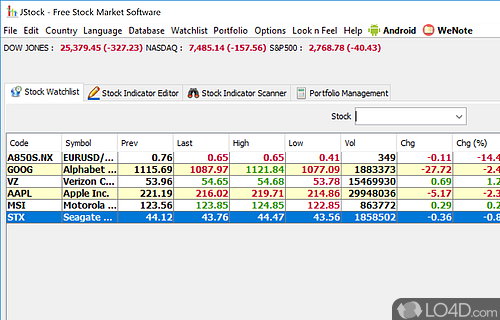

Selecting the action with the tab key requires you to hit the enter key to perform the action, while clicking on it with the mouse normally runs it without any other action (but see the walkthrough below for an exception). To select them you use either the tab key or the mouse. The arrow keys will not allow you to move to the action items at the bottom section of the display. Within sbopkg, you can normally use the arrow keys to select your menu option, use the mouse to select it, or press the letter key for the appropriate menu option. The menu includes a brief description of what each selection does. From the main menu you can select the actions of Sync, Packages, Updates, Browse, Search, Queue, Utilities, and Help.
#Jstock software how to#
Start sbopkg by entering sbopkg at the command prompt.Īt this point I need to briefly describe how to use the sbopkg menus for those not familiar with it.
#Jstock software install#
To install jstock using sbopkg you do the following: The best way to do so is, in my opinion, using the sbopkg program (installation of the sbopkg program was covered in an earlier LXer article which can be found at ). If you want anyone on your system to be able to use jstock, then you need to install it as root. But it is not a system wide installation. This method allows you to always have the latest version of jstock and run it on your system without using the root account. You can, of course, create a launcher to run this program from your desktop or a menu if you wish to do so, but that's beyond the scope of this article, as is the process for installing the correct version of jdk without using sbopkg. Open terminal of your choice, cd to your home directory, and issue the following commands:Īssuming you have a current version of Java installed (jstock is written in java and requires that Oracle's Java 8 be installed to run) you can start jstock by cd'ing to the jstock directory and typing: At the time of this article that is version 1.0.7.13, and the file to download is jstock-1.0.7.13-bin.zip. To manually install jstock in your own directory, first download the latest version from the jstock website and save it to your home directory. The second is to use sbopkg to install it. The first is to manually install it in your own user directory. There are two ways to install jstock on your Slackware system. This article is not intended to be review of the software but rather a walkthrough describing how to get it working with Slackware.

#Jstock software full#
LXer recently linked to a full review of jstock (which you can find at. There is a website for the jstock software ( ), from which you can download the latest versions and the source code. It is a full featured product on par with those offered by the various online stock brokerages (Etrade, TD Ameritrade, and Scottrade, for example). It includes analysis and charting software to aid you in picking stocks you may wish to investigate further. Jstock is an open source program for tracking and analyzing your investments.

Two methods to get Jstock working on your Slackware 14.1 machine. Installing jstock with Slackware 14.1 Posted by jdixon on 12:00 AM


 0 kommentar(er)
0 kommentar(er)
